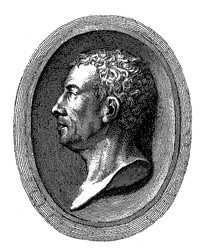Johann Caspar Carsted Koenigl. Preussl. Feldprobst und INSPECTOR des gesamten Feld=MINISTERII, wie auch GUARNISON=Prediger und ASSESSOR des Kriegs=CONSISTORII zu Berlin. Gebohren zu Bismarck 1684 den 2ten Decembr. Gestorben zu Berlin 1752 den 21ten Aug. Im 68ten Jahr seines Alters und 37ten seines Amts.
u.r.: J. E. Gericke, Sculps. Berol 1753
Dargestellt ist ein nach links gedrehter, fülliger Mann. Er trägt eine lange, schwarze Robe und ein Beffchen. Mit der rechten Hand fasst er sich an den Gürtel, die linke liegt auf einem aufgestellten Buch. Sein Kinn steht auffällig hervor. Er trägt eine Perücke mit langen, lockigen Haaren. Ein ornamentaler Rahmen begrenzt das Porträt. Darunter ist ein Schriftfeld auf dem Kapitell angebracht (s.o.).
Nach dem Vorbild von T. Huber
en

